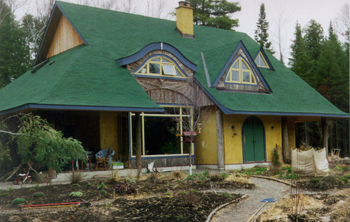Straw Bale House Fits Family's Lifestyle Perfectly
by Wendy Priesnitz
 Straw bale construction is in the midst of a remarkable revival across North America. And a visit to David and Ann-Marie Warburton’s unique, three-year-old post and beam straw bale home explains why. The two-story, three-bedroom 2,475 square foot Warburton home combines high energy efficiency, low environmental impact and serene simplicity on 3.5 acres, an hour north of Toronto, Ontario. Straw bale construction is in the midst of a remarkable revival across North America. And a visit to David and Ann-Marie Warburton’s unique, three-year-old post and beam straw bale home explains why. The two-story, three-bedroom 2,475 square foot Warburton home combines high energy efficiency, low environmental impact and serene simplicity on 3.5 acres, an hour north of Toronto, Ontario.
The home suits the family’s lifestyle and desire to live more in touch with the earth. Their treed property includes 600 feet of frontage along a beautiful river and provides plenty of room for two kids and a new litter of puppies, as well as two home offices. David is a self-employed garden designer/ builder and Ann-Marie telecommutes from her home office for Bell Canada.
The couple’s first exposure to the use of straw construction was in New Mexico. Says David, “We were in a restaurant and got chatting with the owners. They were renovating the old building and had said, ‘Come upstairs...we’ve got something to show you.’ They’d torn off the walls and discovered straw behind them.”
Sometime later, straw as a construction material re-entered their lives. Attending a Permaculture event held at a conference center just down the road from the building site, they met Canadian architect Linda Chapman, who has been actively involved in straw bale construction since 1993. She has designed and built many straw bale homes across the country and, with the help of the federal government, has published two reports of research findings on straw bale walls.
The Warburtons knew they didn’t want to build a conventional house on their property. So when Chapman suggested straw bale, they researched it and were pleased with what they learned. “There were no rude surprises,” is how David describes it. “We looked at logs, but found it to be more challenging. And straw bale hasn’t disappointed us. It was easy and efficient. And the house has a wonderful solidity. It is cool in summer due to its mass. And it’s quiet.”
Construction began in July 1998 and the family moved in just before Christmas that year, with some interior finishing still to be done. For those who worry that unconventional houses may be difficult to finance, it’s important to note that the Warburton house has a conventional bank mortgage and regular home insurance.
Anne-Marie acted as general contractor for the project. She had experience self-contracting a conventional home but had never been involved in building with straw. She admits, “I had read a book and seen a video, but had no hands-on experience with straw bale construction. That, in retrospect, was a mistake.”
She contracted with professional builders for the foundation slab, post and beam construction and interior walls, wiring and plumbing. “But once the frame was up”, she laughs, “the builders told me to call them when the walls were in place! ...So I had to scramble to find volunteers to raise the straw bale walls.”
Fortunately, she says, enthusiastic volunteers “came out of the woodwork.” She says there are people who donated their time that she and David don’t even know, so they’ve never been able to thank them.
Marveling at how everything fell into place, she says, “One day [straw bale builder, author of the book Straw Bale Building] Peter Mack drove by and asked if he could help. He was a great help for the straw bale part.”
Due to Anne-Marie’s inexperience with straw bale building, she had scheduled insufficient time for the baling and wiring process. What she had thought would take one weekend took three weeks and led to some volunteer scheduling hassles. But eventually, in November of 1998, 20,000 square feet of stucco was applied to the walls in three coats.
The house is as much a work of art as it is environmentally careful. The wood on the first floor was milled on-site, from the trees cleared for the house. And the rest came from a neighbouring property. The well-worn floorboards on the first floor were recycled from the 100-year-old former Planters Peanut Factory in Toronto.
One of the major concerns of potential straw bale builders is getting a building permit. Peter Mack and his partner Chris Magwood say in their book Straw Bale Building that “if you are committed to building with bales, you will be able to get a permit for a soundly designed structure.”...although they admit it could take some time and hassle. Since the Warburton’s home was designed by an architect and engineer, Ann-Marie says they weren’t too worried. And she was right. The local building inspector happened to be interested in old building techniques. So he quickly became knowledgeable and supportive. He even sent some volunteers to help raise the walls.
With finishing touches continuing to be provided by a variety of local artisans and David’s professional touch shaping the gardens, the Warburton’s straw bale home is a work-in-progress that suits their lifestyle and personalities in a way that it’s doubtful a conventional house could.
Wendy Priesnitz is the Editor of Natural Life Magazine and a journalist with over 40 years of experience. She has also authored 13 books. This article was published in Natural Life Magazine in 2000.
|

